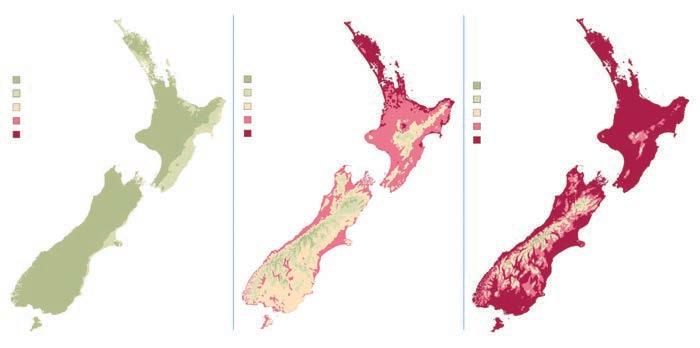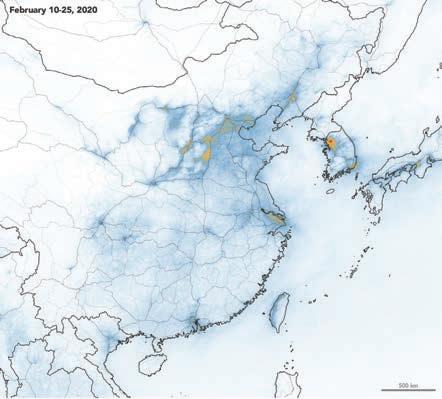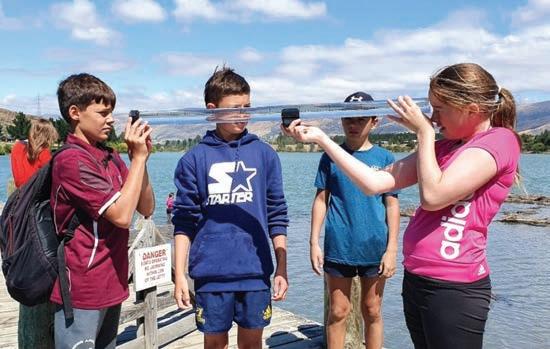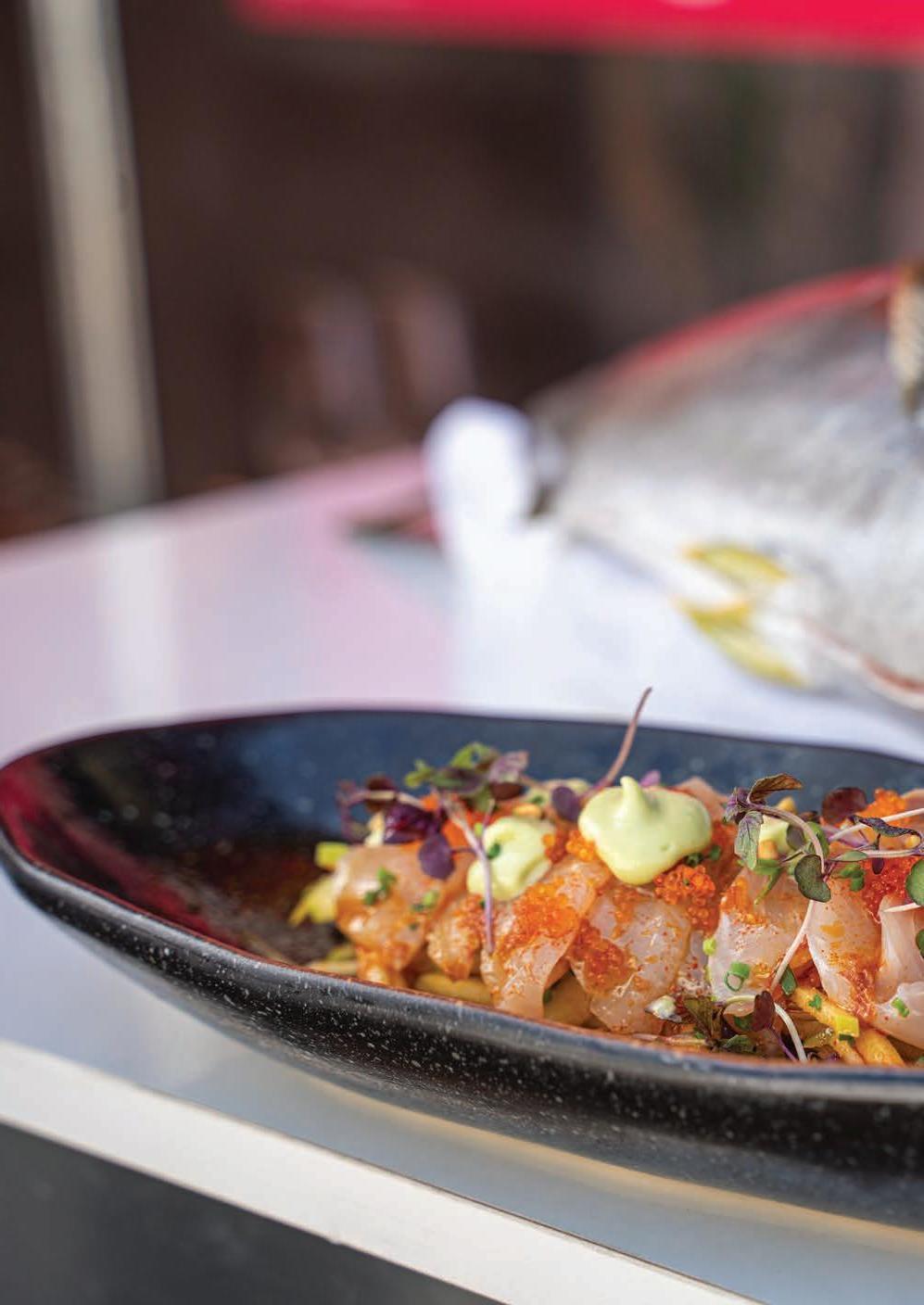
18 minute read
Building pathways
It has been a whirlwind first six months for Ngāpera Keegan and Tekiteora Rolleston-Gabel, the first two young researchers in NIWA’s newly established Māori Graduate Internship Programme. Alex Fear caught up with them to check on their experiences so far.
Ngāpera Keegan
Advertisement
Iwi: Waikato-Maniapoto, Ngāti Porou, Ngāti Raukawa ki Te Kaokaoroa-o-Pātetere. Hapū: Ngāti Apakura Ngāpera Keegan worked for two nights under the June full moon alongside Masters student Siobhan Nuri catching glass eels as they entered the Rangitāiki River mouth in the Bay of Plenty. “We caught over 1400,” explains Ngāpera. “We identified all the glass eels to species under the microscope, measured and weighed a subsample of them and returned them to the river the next day. We also counted all other fish species, which included herring, smelt and even a recently hatched īnanga larva.” “This year’s sampling was six weeks earlier than in 2019, and we weren’t expecting to catch that many. We sat on the bank watching the moon rise on the second night, trying to work out why there were so many this time of the year. It was so cool to be part of that.” The interns work across NIWA for 12 months
NIWA, through its Māori Environmental Research team Te Kūwaha, is working in collaborative partnerships with Māori businesses, and whānau, hapū and iwi throughout Aotearoa, combining their skills in scientific enquiry with mātauranga
Māori expertise, within the frame of tikanga
Māori. Demand for this capability in Aotearoa–
New Zealand, is growing, and the pathways for early career researchers are few, resulting gaining, practical experience, building networks and developing a platform from which to consider a long-term research career. They gain experience in freshwater, marine and estuarine science, fisheries, aquaculture, climate change and hazards, social research and mātauranga Māori, while learning how to communicate eectively with Māori and work collaboratively across disciplines. The internship has involved a diverse range of projects to date for the Bachelor of Sciences graduate. As well as field work, analysing samples and processing data, Ngāpera has created an educational booklet about īnanga as part of NIWA’s taonga species series. “I chose to do īnanga because it’s an important species for inland tribes, so being from Waikato and Maniapoto, it’s an important species to research for me,” says Ngāpera. “I am so grateful to have had this opportunity to experience all that I have so far. I want to tell everyone that if they get the chance to be part of this
NIWA Māori Graduate Internship Programme
– do it.” in a scarcity of expertise. NIWA’s Māori Graduate Internship programme has been established to help address this growing need, while also supporting and creating visible pathways for the next generation of Māori researchers. The purpose of the programme is to encourage Māori science graduates to consider ongoing postgraduate study and Māori environmental research as a career pathway.
Tekiteora Rolleston-Gabel
Tekiteora Rolleston-Gabel
Iwi: Tūhoe, Ngāti Kahu, Ngāi Te Rangi, Ngāti Awa A double graduate in ecology and Te Reo Māori from the University of Waikato, Tekiteora Rolleston-Gabel says she is not just interested in the interactions between animals “but also people, places and the environment.” “I’m amazed by the range of projects NIWA is involved in, and how they’re being implemented to support communities and their environmental aspirations.” Tekiteora saw this in action on a recent trip to Umupuia marae to support a tuangi (cockle) survey. Ngāi Tai ki Tāmaki kaitiaki have been working with the Te Kūwaha team to develop a cultural assessment framework for their rohe moana. This draws on their cultural values, observations, monitoring and mātauranga, while also using some of the assessment tools in Nga Waihotanga Iho – NIWA’s estuarine monitoring toolbox. “I got to see how Te Kūwaha supports this whanauled process,” says Tekiteora. “It was so exciting to be part of this. It made me wonder about how these tools may be applied to contribute to the environmental aspirations of my own hapū and iwi.” Tekiteora says it’s the little, unexpected moments of discovery that have been the most memorable for her. “Getting to experience those moments, and working with so many researchers in such diverse fields, has been such a great experience. It has reinforced my desire to go on with environmental science. This is where I want to be.”
Fresh thinking – new solutions
Getting tangled up in seaweed or using supercomputers to unravel climate change – NIWA scientists go to great lengths to find fresh answers. Sam Fraser-Baxter talks to five researchers about their innovative projects and what difference their work may mean for New Zealand.

Marine biologist Dr Roberta D’Archino maps forests underwater. (Rebekah Parsons-King)
Climate is the new weather
Scientifically, says meteorologist Ben Noll, we have the weather sussed.
Ben Noll
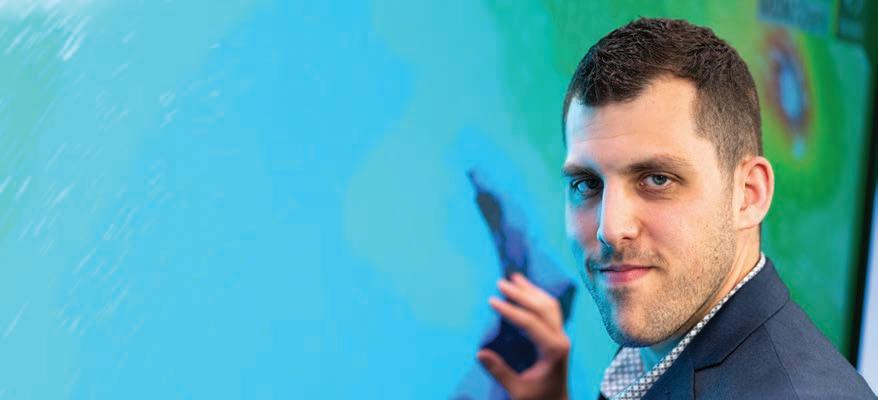
e know what causes it, where it comes from, how it forms, why it rains one day and is sunny the next. We also know what it’s going to do tomorrow and the day after, and we can take a pretty good stab at what it’ll do next week. “We can give a really solid forecast that will be accurate for 28, 29 days of the month,” says Ben. So, job done then? Not quite. These days, at least for meteorologists, climate is the new weather. In other words, the focus has moved to using climate patterns to predict what the weather might do months – or more – into the future. Think of it this way: in 2003 a five-day weather forecast was as good as a one-day forecast in 1953. Fast forward to 2020 and a five-day forecast is as good as a three-day one in 2003. “This illustrates that the time horizon upon which we can make accurate forecasts has increased dramatically. Now we are moving into the longerrange projection space and letting the machines handle the weather.” For NIWA, one example of this is extending the utility of the New Zealand Drought Index (NZDI). This sits on NIWA’s website and is a climate data-based indicator of drought. It is presented as a map, updated daily, and has five categories: dry, very dry, extremely dry, drought and severe drought. For a snapshot of how New Zealand is faring in prolonged dry spells it is an extremely useful tool. “But what if we can create a forecast of the NZDI? We have talked about using the information we have to forecast where that drought will occur over an entire season,” says Ben. NIWA is also working with Emirates Team New Zealand as it counts down to the next America’s Cup. NIWA uses its supercomputers to run weather models at higher resolutions than ever before. The forecasts are so detailed, says Noll, you can see the wind bending around tiny islands in the Hauraki Gulf. “These models help us understand the atmospheric and sea state better than ever, and to see Emirates applying and using our model is really exciting.” The supercomputers also run what are known as “ensembles”, in which weather models are processed 18 times, and the dierences between them analysed to better understand the potential for hazards and extremes. Work is also ongoing to combine seasonal forecasting modelling with machine learning to identify weather extremes over a given season, with the aim to forecast how many days might exceed 30 degrees or have more than 25 mm of rain, and much more. You might even say – as Ben does – that the future looks bright for forecasting.
Trawling to order
Marine ecologist Dr Emma Jones and fi sherman Karl Warr share the same goal.
Dr Emma Jones
Cameras and control systems mounted on the trawl net enable fi shing operators to control the net entrance and avoid unwanted bycatch. (NIWA)
oth look forward to the day when Karl can o er his customers an underwater online shopping experience; the customer orders what they want each day, and Karl only catches what is ordered. It’s a reality that Emma believes isn’t too far o . “Because so many of the world’s fi sheries are overfi shed, a highly targeted approach to fi shing is the way forward.” Emma has been working with Karl on targeted fi shing systems for the past four years. Karl had already taken some novel steps on his own Hawke’s Bay-based boat towards reducing bycatch – the undersized or non-target species that must either be thrown back or landed, with penalty costs incurred. The mesh sizes on a standard, fi bre-based cod-end at the end of a trawl net close up as the net is pulled in. This tends to cram the catch – large or small –together at the back. But Karl now uses a sturdy, metal cage at the end of his trawl net, enabling small fi sh to more easily escape through the rigid openings. He avoids undersized specimens and because the fi sh he does land are in better condition, restaurants around the country are willing to pay top-dollar for Karl’s sustainable catch. A study by Emma demonstrated that Karl’s cage codend reduced unwanted bycatch by up to 80%. But Karl was already thinking of how to go further. Emma says that Karl referred to his cage as “the analogue version.” “A digital version would be something that had ‘eyes in the trawl’, providing real-time knowledge of what’s going into your net and being able to make decisions about what you keep and what you don’t.” At the time, Emma was aware of projects using underwater cameras and artifi cial intelligence to automate fi sh identifi cation. If those technologies could be used in a scientifi c study, why not on a commercial fi shing boat? The pair have been working on prototypes over the last few years. Cameras attached to the trawl fi lm fi sh entering the net. Onboard, an operator watches the video and chooses when to open the gate, determining which fi sh are retained in the net and which fi sh aren’t, similar in concept to the drafting of sheep. In the future, Emma says the process of identifying, measuring and selecting fi sh for retention will be automated by artifi cial intelligence. While the technology is still being developed, Emma believes it has the potential to enhance the economic and environmental future of fi shing industries worldwide. Asked if the technology could lead to the fi shing industry’s holy grail of eliminating bycatch, Emma is unequivocal. “Yes. Absolutely.”
Vessel wi-fi receiver

Live data feed to vessel Wi-fi sensor buoy

Drafting gate
Trawl-mounted camera and control system
DEEP VISION
Cage cod-end
A river runs through it
At 5.45pm on 27 March 2019, a state of emergency was declared in Westland.
Hydrological forecaster Dr Céline Cattoën-Gilbert. (Simon Hayes)
prodigious front had descended on the South
Island’s West Coast, bringing record rainfall. Swollen rivers burst their banks and just hours later floodwaters washed away the Waiho bridge – severing the only road running through south Westland. The rainfall was a sobering reminder of the threat posed by climate change. New Zealand is expected to experience more frequent and more intense rainfall events in future. So, when the rain comes, where does it go? And when does it go there? Dr Céline Cattoën-Gilbert is working to answer these questions. She is a hydrological forecasting scientist developing New Zealand’s first national-scale river flow forecasting system. The tool will provide hourly river flow forecasts, 48 hours in advance, for more than 60,000 rivers across New Zealand. Céline will be the first person to tell you that she and her team are standing on the shoulders of giants. The project has been “a long-term NIWA vision” and is built on mind-boggling amounts of science and environmental data collected by others over decades. The system couples the skills of NIWA’s weather forecasting experts with the capabilities of its hydrological researchers – scientists focused on understanding how water moves through New Zealand.
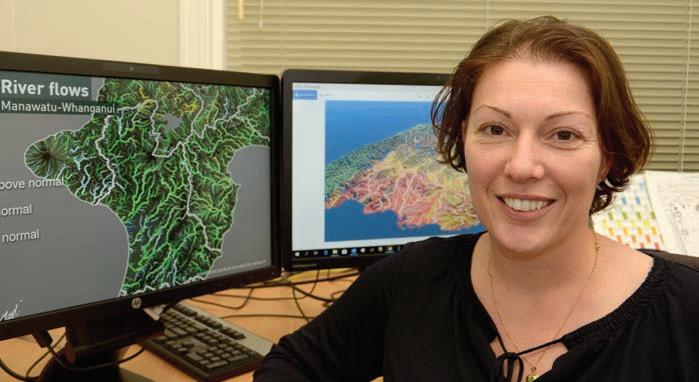
“The weather model gives you precipitation for particular areas, and then the hydrological model tells you how the water travels through a catchment and a river,” says Céline. The information is then fed into the supercomputers at NIWA’s High Performance Computing Facility to generate detailed flow forecasts. Céline sees the results as a key tool to help New Zealanders better prepare for flooding events – the most frequent and costly natural disaster in the country. Céline and her team have been working closely with local authorities and others to co-design and improve the forecasts. Céline says the system complements local models by providing insights into rivers and catchments that councils don’t closely monitor. This wider overview of the way dierent rivers respond to rainfall events is designed to enable councils to better target civil defence responses. The project won’t just help forecast floods. Farmers would be better placed to predict if, and when, rivers may start to run dry. It could also be used to help warn weekend trampers, hunters and anglers about the threat of rapidly rising rivers. While the future is looking wetter and wilder, we won’t necessarily have to turn to Noah’s Ark. When the rains come, Céline’s river flow forecasts should help us weather the storm.
Dr Paula Blackett uses a NIWA Serious Game to highlight the challenges of managing a dairy farm through climate change. (NIWA)
Game changer
When most people think of a science research institute, they think of scientists measuring, monitoring, calculating and comparing.
ll of that is true, but the usefulness of science is also determined by whether people actually take the information learned and apply it in a way that will enhance their lives. That is why NIWA’s team of social scientists plays such a vital role across its research disciplines. They anchor people at the centre of the science, focusing on how they see and understand the world and what influences their decision making. For Dr Paula Blackett it’s one of the most exciting spaces to work in. “We bring to NIWA the importance of people and places, what they value and why and how values will impact their decisions.” The significance of those values has never been more starkly obvious than with the dierent individual responses to Covid-19. “It’s a classic example – everyone was roughly getting the same information, but their responses were completely dierent, and that is due to the weighing up of values. It also proves that providing information on its own and expecting people to act in a particular manner is a complete fallacy – it just doesn’t work like that.” Blackett particularly enjoys working in the field of climate change adaptation. Alongside the engineers, climate scientists and council planners who deliver the facts, she will work with a community to enable them to find the best way forward. One practical way to help communities through this process is use of the “serious games” Blackett and her team have developed. Whether played at the table or online, these games enable players to literally roll the dice on their climate futures – wrestling with all the risks that entails. The games are highly eective in encouraging individuals or groups to understand what their options are, the sequence in which decisions are likely to be made and what they need to do to make their choices occur. “The games are designed to hammer home that risks can be immediate, but they also catalyse people to think about things more deeply, and give them experience of making decisions under uncertainty. “Really what we’re trying to do is to get adaptation and change that will help people to have a livelihood and a happy life, as our climate continues to change.” Putting people at the heart of the climate science.
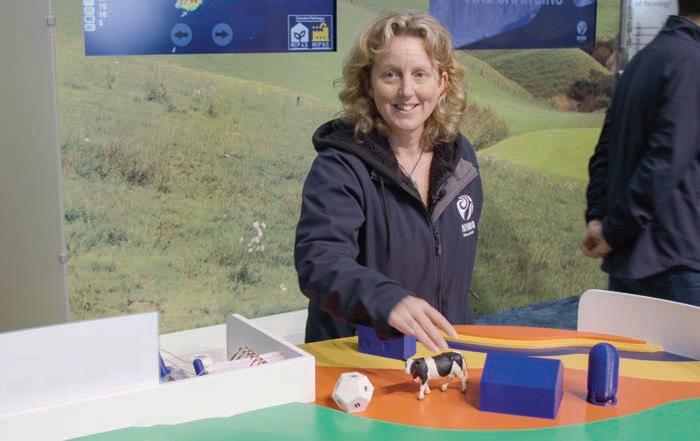
Tangled up in blue
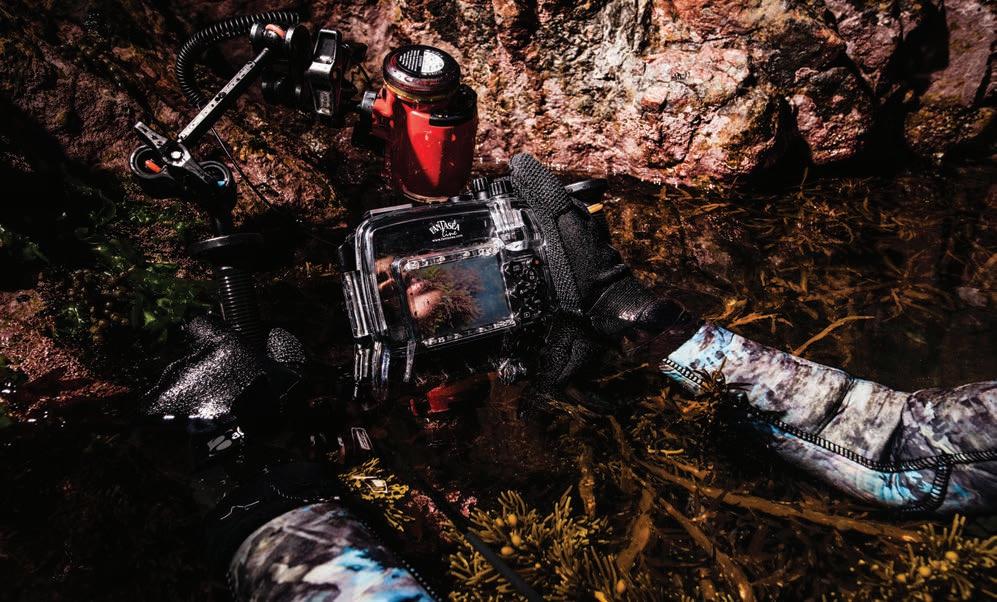
It was love at first sight.
oberta D’Archino was 18 years old when she discovered the beauty of seaweed for the first time. She was scuba diving o the Tuscany coast in Italy in 10m of crystal-clear water. “It was my first dive and I thought I would be interested in fish and invertebrates, but when I saw the red patch of seaweed, I stopped. The instructor had to move me away. Nobody could tell me what the seaweed was, so I was really intrigued.” Roberta is now Dr Roberta D’Archino, and the marine algae specialist is still very much intrigued. She has worked at NIWA for 14 years and says we have a lot to learn about our seaweed. “We know we have more than 1000 species in New Zealand, and many species are still undescribed. Every time I go scuba diving I come back with something new.” She knows one thing for certain, however – seaweed looks set to play an increasingly important role in New Zealand’s future. Marine ecosystems need seaweeds. They protect coastal habitats from the impact of waves. They allow biodiversity to flourish, providing shelter and food for other marine inhabitants, such as fish, pāua and lobsters. But seaweeds also deliver crucial services to those living above the water. As well as a growing list of nutritional and medicinal products, seaweeds produce oxygen, absorb nitrogen and, significantly, fix carbon. They may even help mitigate the amount of methane livestock produce. So how do we gauge the size of the potential carbon sinks stretching along our coastline? And are New Zealand’s seaweed stocks in a state of growth or in decline? Scuba divers working their way through kelp beds to ground truth images derived from satellites or drones make slow progress in answering these questions. Thankfully, Roberta and her colleagues have devised a clever alternative. It involves towing a video camera behind a boat and using a computer – and a speciallydeveloped artificial intelligence (AI) programme – to analyse the resulting video back in the lab. AI is not only cost eective, it is up to 75 times faster than a human can operate and unerringly accurate. “It can identify the three common species of brown algae along the Wellington coast with more than 90% accuracy.” It is a big step towards surveying our seaweed resource at scale and setting up the frameworks needed to enhance our “blue carbon” potential. Equally important for the woman intrigued by all things seaweed, it is a tool that should help New Zealand’s seaweed forests flourish for generations to come.
Dr Roberta D’Archino combines cameras and computers to survey seaweed stocks along coastal shorelines. (Rebekah Parsons-King)
A cold day in the office
Five specialist NIWA divers were left ‘gasping’ during their recent plunge under the ice near Scott Base.
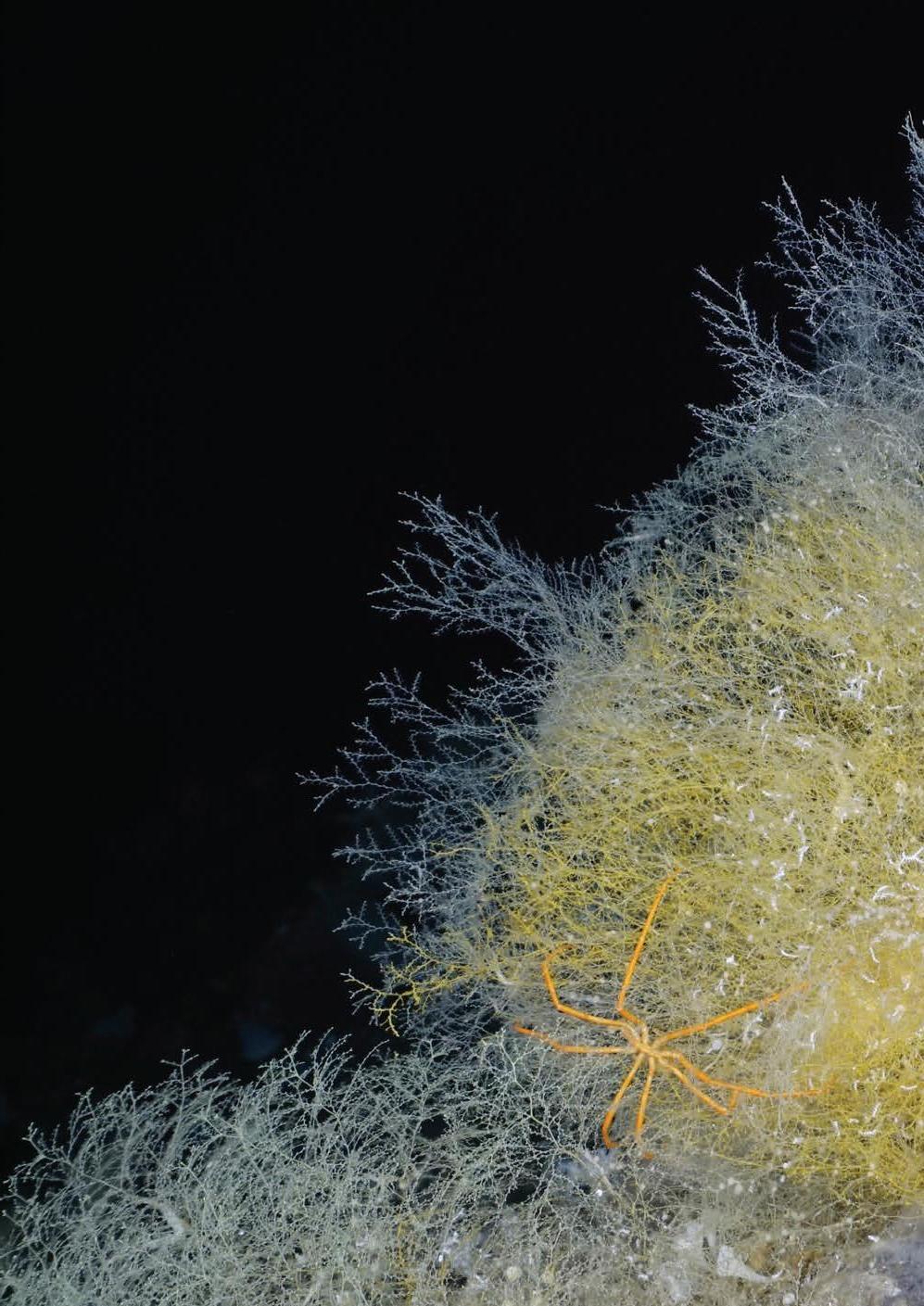
The researchers were working with Antarctica New Zealand to set up experiments and equipment to monitor coastal currents and the marine environment. Full dry suits are mandatory in such icy waters, and you know it’s a cold day at work when your dive mouthpiece sticks to your lips. But it wasn’t the cold that really took their breath away – the team say it was the clarity of the water and the rich diversity of marine life under the Antarctic ice. Photography Peter Marriott
More than 20m under the ice, a large orange sea spider negotiates the delicate thecate hydroid branches attached to a sea squirt (Cnemidocarpa verrucosa). The sea squirt’s open siphon filters plankton and bacteria from the rich Antarctic waters.


Part of the mission was to investigate the strength and direction of underwater currents near Scott Base. This Acoustic Doppler Current Profiler was one of two deployed under the sea ice. Scientific dive specialist David Bremner descends through a 2m thick hole in the ice to begin work. Water temperatures of below minus 1°C cause plate-like ice crystals – known as anchor ice – to form along the seabed.


A delicate spiral egg case – probably deposited by a nudibranch – decorates the outer coating of a large sea squirt. Brittle stars, sponges, soft corals and bryozoans dominate the background.
Sitting on the sea floor 12m below, this 0.5m tall sponge (Rossella racovitzae) is fully encased by anchor ice, yet the aperture which expels filtered water remains free.
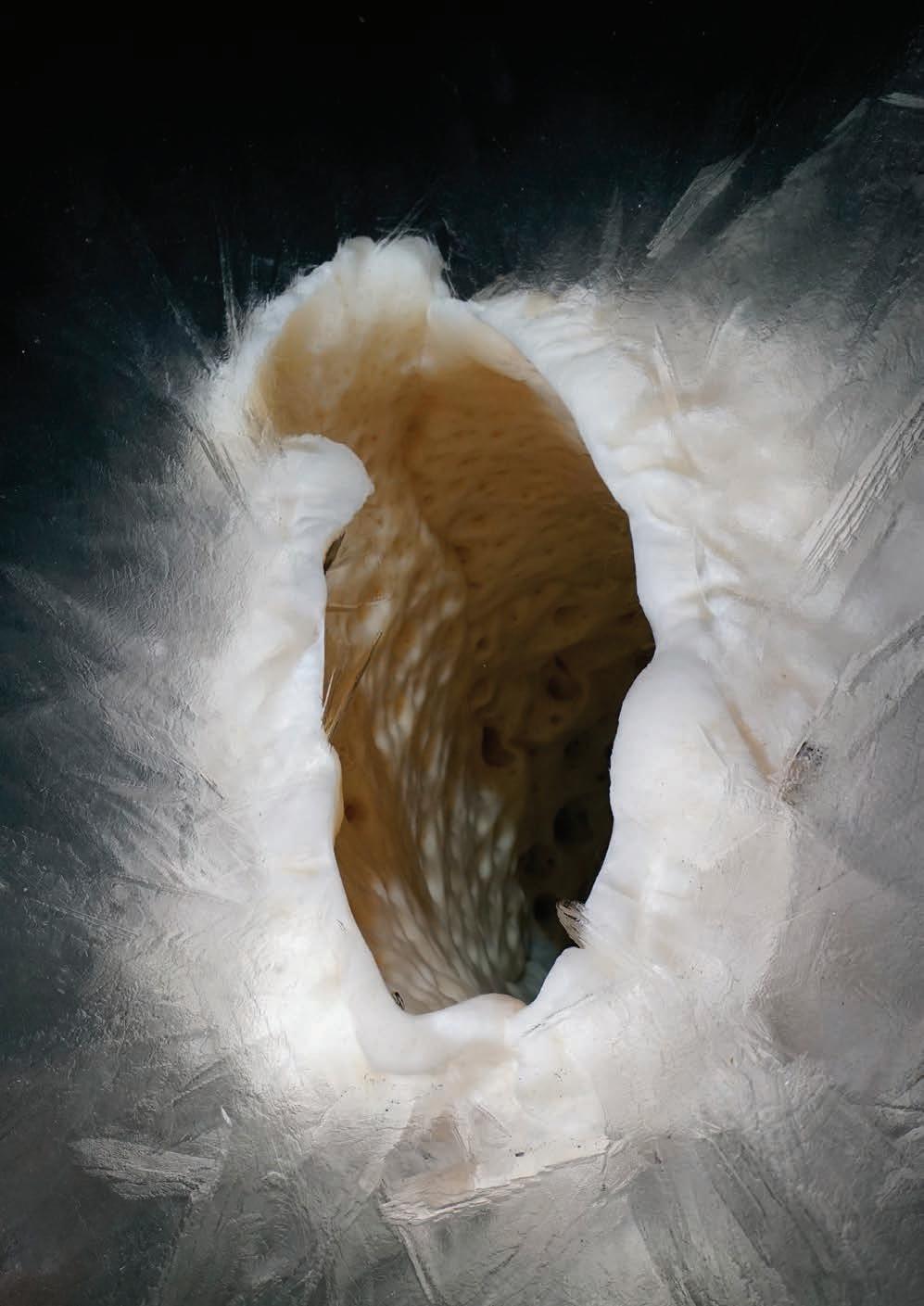
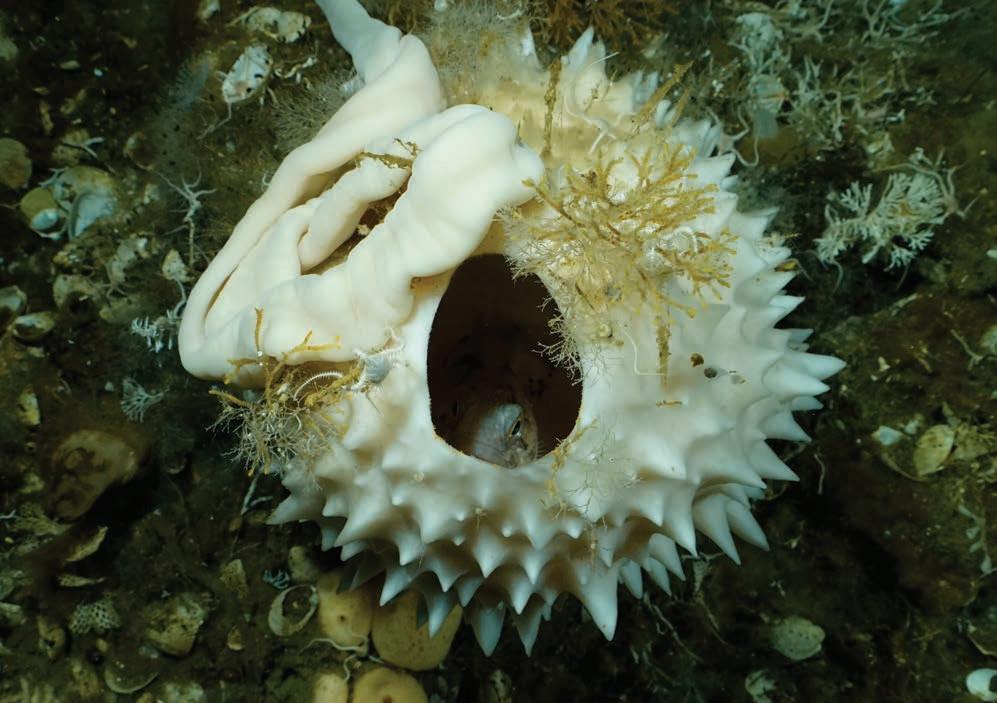
Antarctic creatures often provide vital habitat for others. This large spiky sponge (Rosella racovitzae) is both a platform for a hitchhiking 1m ribbon worm and a hiding place for fish.
Some species have antifreeze glycoproteins in their blood to enable life amongst the anchor ice. Clockwise: a sea urchin, isopod, small blue octopus and emerald rock cod.




Dark patches of algae grow on the sea ice above. Algae are an important food source for seafloor dwellers such as these anemomes, finger-like “bush” sponges and fan worm polychaetes.
A small fish ignores an approaching diver collecting video data along a seafloor transect groundline. Lines are left on site to ensure the same areas are monitored year on year.



